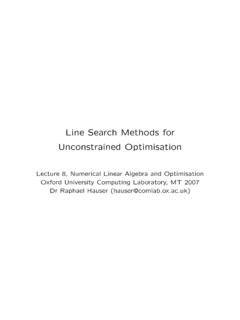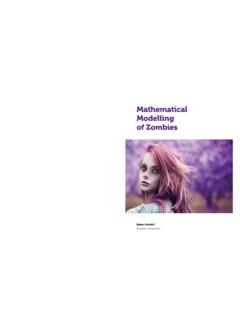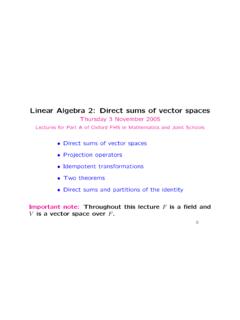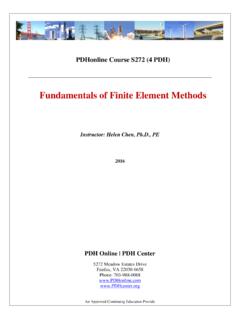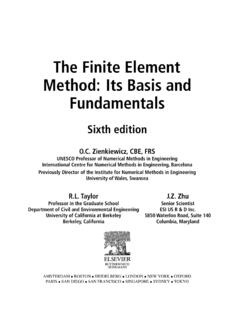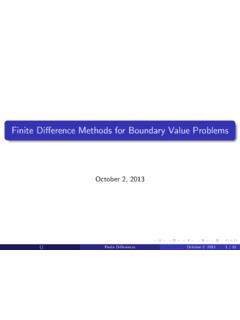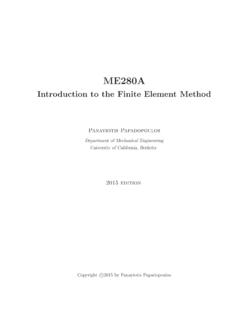Transcription of Lecture Notes on Finite Element Methods for Partial ...
1 Lecture Notes on Finite ElementMethods for Partial DifferentialEquationsEndre S uliMathematical InstituteUniversity of OxfordAugust 11, 20202 Endre S uli, University of Oxford, elements of function spaces .. of continuous functions .. of integrable functions .. spaces .. Weak solutions to elliptic problems .. 142 Approximation of elliptic Piecewise linear basis functions .. The self-adjoint elliptic problem .. Calculation and assembly of stiffness matrix .. Galerkin orthogonality; C ea s lemma .. Optimal error bound in the energy norm .. Superapproximation in mesh-dependent norms .. 563 Piecewise polynomial Construction of Finite Element spaces .. Finite Element .. of triangular Finite elements .. interpolant .. of rectangular elements .
2 Polynomial approximation in Sobolev spaces .. Bramble-Hilbert lemma .. bounds on the interpolation error .. Optimal error bounds in theH1( ) norm revisited .. Variational crimes .. 844 A posteriori error analysis by The one-dimensional model problem .. An adaptive algorithm .. 935 Evolution The parabolic model problem .. Forward and backward Euler schemes .. Stability of -schemes .. Error analysis in theL2norm .. 10434 CONTENTSS ynopsis: Finite Element Methods represent a powerful and general class of techniques forthe approximate solution of Partial differential equations; the aim of this course isto provide an introduction to their mathematical theory, with special emphasis ontheoretical questions such as accuracy, reliability and adaptivity; practical issuesconcerning the development of efficient Finite Element algorithms will also be : elements of function spaces.
3 Elliptic boundary value problems: existence, unique-ness and regularity of weak Element Methods : Galerkin orthogonality and Cea s lemma. Piecewisepolynomial approximation in Sobolev spaces. The Bramble-Hilbert lemma. Optimalerror bounds in the energy norm. Variational Aubin-Nitsche duality argument. Superapproximation properties in mesh-dependent posteriorierror analysis by duality: reliability, efficiency Element approximation of initial boundary value problems. Energy dissi-pation, conservation and stability. Analysis of Finite Element Methods for Brenner & R. Scott, The Mathematical Theory of Finite Element , 1994. Corr. 2nd printing 1996. [Chapters 0,1,2,3; Chapter 4:Secs. , Chapter 5: Secs. ]. Eriksson, D. Estep, P. Hansbo, & C. Johnson, Computational Differential Equa-tions.
4 CUP, 1996. [Chapters 5, 6, 8, 14 17]. Johnson, Numerical Solution of Partial Differential Equations by the Finite El-ement Method. CUP, 1990. [Chapters 1 4; Chapter 8: Secs. ; Chapter 9:Secs. ].Chapter 1 IntroductionPartial differential equations arise in the mathematical modelling of many phys-ical, chemical and biological phenomena and many diverse subject areas such asfluid dynamics, electromagnetism, material science, astrophysics, economy, financialmodelling, etc. Very frequently the equations under consideration are so compli-cated that finding their solutions in closed form or by purely analytical means ( Laplace and Fourier transform Methods , or in the form of a power series) is eitherimpossible or impracticable, and one has to resort to seeking numerical approxima-tions to the unknown analytical Notes are devoted to a particular class of numerical techniques for theapproximate solution of Partial differential equations: Finite Element Methods .
5 Theywere proposed in a seminal work of Richard Courant1, in 1943; unfortunately, therelevance of this article was not recognised at the time and the idea was the early 1950 s the method was rediscovered by engineers, but the mathematicalanalysis of Finite Element approximations began much later, in the 1960 s, the firstimportant results being due to Milo s Zl amal2in 1968. Since then Finite elementmethods have been developed into one of the most general and powerful class oftechniques for the numerical solution of Partial differential equations and are widelyused in engineering design and these Notes we shall be concerned with the mathematical aspects of finiteelement approximation, including stability, accuracy, reliability and adaptivity. Webegin by developing some of the theoretical tools: the present chapter is devoted tosummarising the elements of the theory of function spaces and reviewing some basicresults from the theory of Partial differential equations.
6 The concepts and notationalconventions introduced here will be used systematically throughout the Courant:Variational Methods for the solution of problems of equilibrium and Amer. Math. Soc.,49, pp. 1 23 (1943)2M. Zl amal:On the Finite Element Mathematik,12, pp. 394 402 (1968)56 CHAPTER 1. elements of function spacesAs will become apparent in subsequent chapters, the accuracy of Finite Element ap-proximations to Partial differential equations very much depends on the smoothnessof the analytical solution to the equation under consideration, and this in turn hingeson the smoothness of the assumptions about the regularity of the solution and the data can beconveniently formulated by considering classes of functions with specific differentia-bility and integrability properties, called function spaces.
7 In this section we presenta brief overview of basic definitions and simple results form the theory of functionspaces. For future reference, we remark here that all functions that appear in thesenotes will be assumed to be Spaces of continuous functionsIn this section, we describe some simple function spaces which consist of continuouslydifferentiable functions. For the sake of notational convenience, we introduce theconcept of a the set of non-negative integers. Ann-tuple = ( 1,.., n) Nnis called amulti index. The non-negative integer| |:= 1+..+ nis referredto as the length of the multi index = ( 1,.., n). We denote (0,..,0) by0;clearly|0|= 0. LetD =( x1) ( xn) n= | | x x 1 Suppose thatn= 3, and = ( 1, 2, 3), j N,j= 1,2,3. Thenforu, a function of three variablesx1,x2,x3, | |=3D u= 3u x31+ 3u x21 x2+ 3u x21 x3+ 3u x1 x22+ 3u x1 x23+ 3u x32+ 3u x1 x2 x3+ 3u x22 x3+ 3u x2 x23+ 3u x33.
8 This example highlights the importance of multi-index notation: instead of labori-ously writing out in detail the ten terms on the right-hand side of the last identity,we can compress the information into a single entity shown on the be an open set inRnand letk N. We denote byCk( ) the set of allcontinuous real-valued functions defined on such thatD uis continuous on elements OF FUNCTION SPACES7all = ( 1,.., n) with| | k. Assuming that is aboundedopen set,Ck( )will denote the set of alluinCk( ) such thatD ucan be extended from to acontinuous function on , the closure of the set , for all = ( 1,.., n),| | ( ) can be equipped with the norm u Ck( ):= | | ksupx |D u(x)|.In particular whenk= 0 we shall writeC( ) instead ofC0( ) to denote the set ofall continuous functions defined on ; in this case, u C( )= supx |u(x)|= maxx |u(x)|.
9 Similarly, ifk= 1, u C1( )= | | 1supx |D u(x)|= supx |u(x)|+n j=1supx | u xj(x)|.Example 2 Consider the open interval = (0,1) R1. The functionu(x) = 1/xbelongs toCk( )for eachk 0. As = [0,1]andlimx 0u(x) = , it is clear thatuis not continuous on ; the same is true of its derivatives. Thereforeu6 Ck( )for anyk 0. Thesupportof a continuous functionudefined on an open set Rnis definedas the closure in of the set{x :u(x)6= 0}. We shall write suppufor thesupport ofu. Thus, suppuis the smallest closed subset of such thatu= 0 in \ 3 Letwbe the function defined onRnbyw(x) ={e 11 |x|2,|x|<1,0,otherwise;here|x|= (x21+..+x2n)1/2. Clearly, the support ofwis the closed unit ball{x Rn:|x| 1}. We denote byCk0( ) the set of allucontained inCk( ) whose support is a boundedsubset of . LetC 0( ) = k 0Ck0( ).}
10 Example 4 The functionwdefined in the previous example belongs to the spaceC 0(Rn). 8 CHAPTER 1. Spaces of integrable functionsNext we consider a class of spaces that consist of (Lebesgue-) integrable a real number,p 1; we denote byLp( ) the set of all real-valued functionsdefined on an open subset ofRnsuch that |u(x)|pdx < .Any two functions which are equal almost everywhere ( equal, except on aset of measure zero) on are identified with each other. Thus, strictly speaking,Lp( ) consists of equivalence classes of functions; still, we shall not insist on ( ) is equipped with the norm u Lp( ):=( |u(x)|pdx)1 shall also consider the spaceL ( ) consisting of functionsudefined on suchthat|u|has Finite essential supremum on (namely, there exists a positive constantMsuch that|u(x)| Mfor almost every3xin ; the smallest such numberMiscalled the essential supremum of|u|, and we writeM= |u(x)|).

